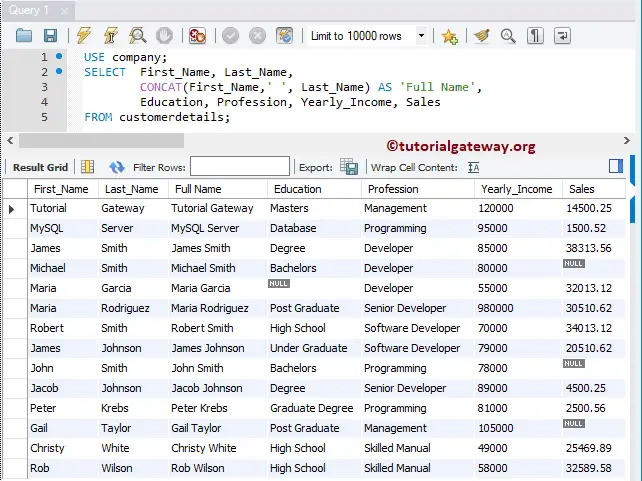

The query is as follows − mysql> select *from selectConcat Mysql> insert into selectConcat values(5,'Sam',22) ĭisplay all records from the table using select statement. Mysql> insert into selectConcat values(4,'Bob',21) Mysql> insert into selectConcat values(3,'Adam',25) Mysql> insert into selectConcat values(2,'John',24) For MIN(), MySQL currently compares ENUM and SET columns by their string value rather than by the strings relative position in the set. The query is as follows − mysql> insert into selectConcat values(1,'Carol',23) mysql> SELECT 'tech' 'on' 'the' 'net' '.com' Result: '' mysql> SELECT 'The answer is ' '24' Result: 'The answer is 24. You can also concatenate expressions together in MySQL by placing the strings next to each other. MySQL puttin a minimum and maximum limit on GROUPCONCAT Ask Question Asked 1 year, 8 months ago Modified 1 year, 8 months ago Viewed 21 times 0 I need to fill the groupconcat with values, no more no less than 4 values, if there is more, create another row of the next 4 until there is no more.
#Mysql concat a minimum how to
Connect to a MySQL server with a username and a password using the mysql command-line client. Let's look at some MySQL CONCAT function examples and explore how to use the CONCAT function in MySQL. Using CONCAT SELECT CONCAT ( 'Happy ', 'Birthday ', 11, '/', '25' ) AS Result Here is the. For older linked servers, the CONCAT operation will happen locally, after the linked server returns the non-concatenated values. The parameters don't necessarily need to be strings themselves. The CONCAT function can be executed remotely on a linked server of version SQL Server 2012 (11.x) and above. CONCAT () returns the string that results from concatenating its parameters. That's why we created this MySQL Cheat Sheet. The CONCAT () function allows you to concatenate two or more parameters. Sometimes, you will need a little help while working on a project. Insert some records in the table using insert command. MySQL is a popular open-source relational database management system known for its ease of use and scalability. The query to create a table is as follows. To understand the above syntax, let us first create a table. OncatenationString’).N from yourTableName SELECT CONCAT(yourColumnName1,’an圜oncatenationString’),CONCAT(yourColumnName2,’an圜 It's not ideal though because a) other databases don't let you get away with it and b) it doesn't guarantee you get a consistent resultset out over time.To concat a field in MySQL SELECT, use the CONCAT() function as shown in the below syntax. If ONLY_FULL_GROUPBY mode is off (in mySQL) then you get away with how you wrote your query (you only grouped by ID, you neither grouped nor aggregated the name/image) because it effectively just picks a random single value from the resultset per ID. MAX(`products`.`name`) as name, -if not in the GROUP BY, must be in an aggregate function hereīut you can't (shouldn't, even though MySQL lets you) mention columns in the SELECT that are neither in the GROUP BY or in an aggregate function (like MIN) MAX(`products`.`image`) as image, -if not in the GROUP BY, must be in an aggregate function here `products`.`name` -name in the SELECT should be in the GROUP BY `products`.`image`, -image in the SELECT should be in the GROUP BY MIN(product_prices.price + 0) as min_price Inner join `product_prices` on `product_prices`.`products_id` = `products`.`id` mysql> SELECT CHAR (77,121,83,81,'76') -> 'MySQL' mysql> SELECT CHAR (77,77.3,'77.3') -> 'MMM' CHAR () arguments larger than 255 are converted into multiple result bytes. MIN(CAST(product_prices.price AS UNSIGNED)) as min_price Insert into product_prices (price,products_id) values('456','1') Insert into product_prices (price,products_id) values('324','1') First: SELECT ticketingticket. Keep this in mind when converting SQL statements to MySQL. MySQL Is Different Most DBMSs use operators + or for concatenation MySQL uses the Concat () function. Insert into product_prices (price,products_id) values('34','1') In MySQL SELECT statements, you can concatenate columns using the Concat () function. Insert into products(name) values('PR1') KEY `product_prices_products_id_index` (`products_id`) The following discussion describes how to write statements that use CTEs. `products_id` bigint(20) unsigned NOT NULL, 13.2.20 WITH (Common Table Expressions) A common table expression (CTE) is a named temporary result set that exists within the scope of a single statement and that can be referred to later within that statement, possibly multiple times. `price` varchar(255) COLLATE utf8mb4_unicode_ci NOT NULL, `name` varchar(255) COLLATE utf8mb4_unicode_ci NOT NULL, `id` bigint(20) unsigned NOT NULL AUTO_INCREMENT, See the following customers table in the sample database. Your problem is that your price is not a Number CREATE TABLE `products` (


 0 kommentar(er)
0 kommentar(er)
